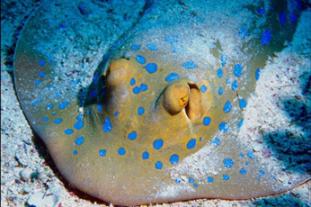Blue-Spotted Stingray (Taeniura lymma)

The blue spotted stingray (Taeniura lymma) is an unsual bottom-dwelling fish that inhabits the Indo-Pacific.
It belongs to the family Dasyatidae.
Like all of the rays, the blue-spotted stingray has a flattened body and also a venomous barb located near the base of its tail. Its mouth and gills are located on the underside of its body, and its eyes are located on top of its body.
Stingrays often bury themselves in the sand keeping only their eyes visible.
Watch the short You Tube video below to see a close up view of a stingray's underside. It shows an excellent view of a ray's mouth and gills. The ray in the video isn't a blue spotted stingray, but the structure of the mouth and gills are the same for all rays.
As you can see from the location of the stingray's mouth in the video, they are definitely bottom feeders.
What makes the blue-spotted stingray different from the other rays is its colorful blue spots on the upper side of its body and the two blue stripes on the sides of its tail.
In general, rays aren't commonly kept in the home aquarium, however, when rays are kept, the blue-spotted stingray is the most commonly kept ray.

Many stingray species grow too large to keep in a home aquarium. Even a very large aquarium. For example, manta rays often reach a diameter of over 25 feet (7.62 m) and so aquarists don't usually keep these.
Blue-spotted rays are more commonly kept because they only reach a maximum size of about 12 inches (30 cm) in diameter. Keep in mind that this doesn't include the length of their tail.
Although the blue-spotted stingray doesn't grow as large as some of the other ray species, you still need a VERY spacious aquarium to house one. Your ray must have A LOT of swimming room. You will also need to provide your blue-spotted stingray with some rockwork for hiding places.
They also need a sandy substrate so they can bury themselves in it. If you use substrate other than sand, your stingray may injure its underside. Stingrays also feed on crustaceans and bivalves that live in the sand.
Obviously, stingrays don't make good reef tank inhabitants because they'd eat all of your crustaceans and molluscs.
Blue-spotted stingrays are sometimes reluctant to feed in captivity. Feeder shrimp are sometimes used to encourage feeding behavior. You can also feed your stingray chopped up seafood, and other meaty marine-based fish foods. Stingrays are carnivores.
In general, it is very difficult to keep these rays happy and healthy in captivity.
Also, lets not forget about the venomous spine at the base of their tail. If you keep a stingray in your aquarium you will have to be very careful not to get stung. Stingrays are capable of quickly moving their tail around to sting potential predators. Not only is the barb sharp, but it is also poisonous, although their sting is usually not fatal.
Stingray Reproduction
The male stingray inseminates the female using a pair of claspers (modified pelvic fins used by male stingrays for internal fertilization). Stingrays are ovoviviparous animals, which means the fertilized eggs remain inside the female stingray until they hatch. At the end of the gestation period the eggs hatch and live stingray fry are released.
Blue-spotted stingrays generally sell for about $160 each. However, they often don't do very well in captivity and so unless you have a very spacious aquarium and are very experienced at keeping saltwater fish, then it is best to leave the blue-spotted stingray in its natural habitat.
